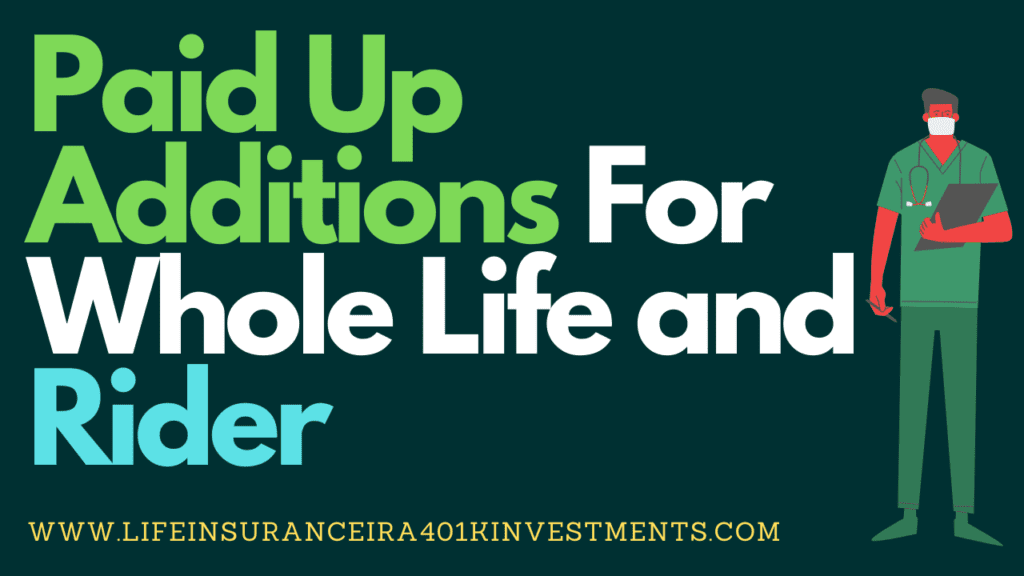What Is Paid Up Additions?

Additional paid insurance is additional life insurance coverage that an insured person purchases with the insurance dividends instead of the premiums. The additional insurance paid is available as an additional clause in a lifetime policy. It allows the policy holder to increase their life and death benefits by increasing the cash value of the policy.
Additions paid for yourself generate dividends and the value continues to rise indefinitely over time. The insured can also deliver paid surcharges for his cash value or take out a loan against him
What Is Paid Up Additions?

Paid additions are small pieces of full life insurance stacked on an ordinary whole life policy. However, paid additions are paid in full at one time, either with a one-time premium payment in an additional PUA clause or by choosing the dividend option for dividends to buy paid additions.
| Sl. no. | Insurance Plans | Price |
| 1. | Paid Up Insurance | $30/Mo |
| 2. | Whole Life Insurance | $32/Mo |
| 3. | Cash Value Insurance | $56/Mo |
After an initial premium charge of between 5% and 10%. There are zero ongoing mortality charges dragging down the growth of a PUA’s cash value. This is the power of paid additions!
Below, we’ll show you how adding an additional Paid-Additions clause to an ordinary whole life insurance policy. Can make it a good investment vehicle due to the disproportionate amount of PUA that can be included in your policy.
Are paid additions taxable?
Unlike dividends, which are in the interests of the insurance company, paid additions are not taxable. The cash value insurance of a PUA grows deferred for tax purposes and the death benefit is tax-free. Because technically it’s a miniature life insurance policy in itself.
If you buy a single life insurance policy with a single premium, you are violating the IRS premium thresholds and your one-time premium. The entire life insurance is immediately classified as a Modified Endowment Contract (MEC). That loses some of the tax advantages. Key to normal life insurance.

How additional paid Insurance works?
Another benefit is that the policyholder can use them to increase coverage without taking out a medical subscription. Not only is this convenient, but it is also an added value for a policyholder.
Even without a medical subscription, additional paid insurance may have a higher premium than the base policy. Since the price depends on the age of the policyholder at the time the additional senior life insurance is taken out. Some policies, such as those issued by the Veterans Administration, do not have premiums for paid supplements.
If you take out two life insurances that are otherwise identical with the same annual premium. But one has a payment clause and the other does not, the one with the clause has a higher guaranteed net present value than the other does not. However, a policy that allows initially paid additions may have a lower cash value and a much lower death benefit. It will be many years, possibly decades, for the two directives to receive similar death benefit.
Cheap Life Insurance Companies
Only mutual insurance companies owned by their members pay dividends. Dividends are not guaranteed, but are usually issued annually if the company is financially sound. When an insured does not want to use his dividends to take out additional paid insurance
Some companies may allow you to add it later, but health, age, and other factors can make it difficult. Additional paid insurance policies can vary between cheap life insurance companies.
For some, the paid supplement schedule can add so much to you. Or as little as you like from one year to the next.
The guaranteed growth and death benefit of a paid addition
Since a PUA is like a miniature whole-life policy, no more premiums should be paid. Let’s go back and see how Whole Life works. This excerpt below our article. “Guaranteed Lifetime Growth and 4 Ways to Speed It Up” will help you understand the power of a paid addition.
“Essentially, a whole life insurance policy is actuarial designed so that its cash value equals your death benefit. Either immediately when the insured dies or at age 120, whichever comes first … Even if you don’t have Intent to reach 120 years, your Whole Life policy.On this path to your guaranteed death benefit, the cash value increases every year. Be very clear that this is the central growth engine of lifelong politics. Unaffected by prevailing interest rates, economic recessions, the company’s profitability and so on.”
Life insurance History
See how the growth in guaranteed cash value steadily converges to the $ 1,000,000. Death benefit, although this particular policy is a lifelong payout at age 65. CV = DB at age 120 (or earlier if you die sooner).
PUAs actually raise the bar for guaranteed cash value growth through paid life insurance
Remember how the cash value of an out-of-pocket policy should equal your 120-year death benefit. And how does this contractual constant set the course for your guaranteed growth in cash value insurance?
As each PUA takes out paid life insurance, these small paid policies keep piling up. Essentially, increase the death target that your Guaranteed Present Value must meet
Example of additional paid Insurance
Imagine a 45 year old man buying a lifetime policy. With a base annual premium of $ 2,000 for a death benefit of $ 100,000. In the first year of the policy, you choose to add an additional $ 3,000 to an additional paid plan. The paid supplements give you instant cash value. From $ 3,000 and $ 15,000 to your death benefit. If you continue to buy paid additions, you will continue to increase your cash value and death benefit over time.
Almost all dividend-paying life insurance policies allow policyholders to keep their dividends. Paid supplements are identified through the Buying Supplemental Coverage Policy. Think of paid additions as small policies that require only a premium. They are “fully paid” immediately.
In addition to their dividends on their policies to buy paid supplements. Whole life dividend payout holders can also add a Paid Supplements Supplement to their policies, which allows them to purchase additional Paid Supplements by managing a portion of your insurance policies, allowing them to purchase additional paid additions by managing a portion of your premium directly to the purchase of paid additions.
When you regularly purchase paid additions through a Paid Addendum Addendum, you are significantly loading your policy growth.
In fact, whether you buy paid additions with annual dividends or through a Paid Add-ons Schedule, or both. Paid additions increase both the death benefit of your life insurance policy and its cash value.
And here’s the icing on the cake: paid additions can pay dividends. That means that its value can increase over time.
Compete risk-free with $100,000 in virtual cash
Test your trading skills with our FREE stock simulator. Compete with thousands of Investment merchants and trade to the top! Submit trades in a virtual environment before you start risking your own money. Practice trading strategies so that when you’re ready to enter the real market, you have the practice you need.

As you age, even if you are automatically approved to fund your paid addition schedule. The same amount of PUA premium buys you less paid insurance than last year. The resulting amount of additional cash value will be the same as the prior year. But will support less insurance paid.
Basically, as you get older, your paid life insurance costs increase more and more. To buy the same amount of paid life insurance as the previous year. You must pay a slightly higher one-time premium each year you age.
Looking at the value-paid formula differently, since that individual premium has less time to reach its 120-year death benefit destination. You essentially must load it with more premium dollars from the jump.
Paid additions are the most efficient way to generate cash value
First, it is important to understand that paid additions are only available on full life insurance policies issued as participating policies. If you have a “participating” policy. When your insurance company pays dividends, as the policy owner, you share the profits of your insurance company.
Universal life, indexed universal life, and variable life policies do not offer paid additions. The term policies also do not offer paid additions. Paid additions are a unique feature of dividend-paying whole life insurance policies.
Second, with insurance companies preferred by authorized Bank On Yourself advisors. No one earns a commission when they use their dividends to buy paid additions. 100% of your dividend goes toward buying additions paid by you, and you will see a dollar-for-dollar. Increase in the cash value of your policy.
With high cash value life insurance policies, the name of the game is cash value – money in your policy. That you can use for many, many reasons now, while you live. So when you leave your policy dividends on your policy to buy paid additions, particularly when there are no commissions, taxes, or other expenses involved.
Even though every penny of dividends used to buy paid additions. Goes directly to cash value, it also increases your death benefit.
- What Is Paid Up Additions? Learn More About Here. https://en.wikipedia.org/wiki/Whole_life_insurance